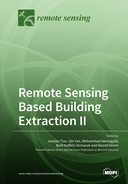Explore

Remote Sensing Based Building Extraction II
0 Ungluers have
Faved this Work
Login to Fave
Building extraction from remote sensing data plays an important role in geospatial applications such as urban planning, disaster management, navigation, and updating geographic databases. The rapid development of image processing techniques and the accessibility of very-high-resolution multispectral, hyperspectral, LiDAR, and SAR remote sensing images have further boosted research on building-extraction-related topics. In particular, to meet the recent demand for advanced artificial intelligence models, many research institutes and associations have provided open source datasets and annotated training data, presenting new opportunities to develop advanced approaches for building extraction and monitoring. Hence, there are higher expectations of the efficiency, accuracy, and robustness of building extraction approaches. Additionally, they should meet the demand for processing large city-, national-, and global-scale datasets. Moreover, learning and dealing with imperfect training data remains a challenge, as does unexpected objects in urban scenes such as trees, clouds, and shadows. In addition to building masks, more research has arisen on the automatic generation of LoD2/3 building models from remote sensing data. This follow-up Special Issue of “Remote Sensing-based Building Extraction”, has collected more research on cutting-edge approaches to essential urban processes such as 3D reconstruction, automatic building segmentation, and 3D roof modelling.
This book is included in DOAB.
Why read this book? Have your say.
You must be logged in to comment.
Rights Information
Are you the author or publisher of this work? If so, you can claim it as yours by registering as an Unglue.it rights holder.Downloads
This work has been downloaded 75 times via unglue.it ebook links.
- 75 - pdf (CC BY) at Unglue.it.
Keywords
- airborne Earth observation
- airborne LiDAR
- attention enhancement
- building extraction
- building footprint
- building model
- building photovoltaic
- building reconstruction
- convolutional neural network
- convolutional neural networks
- cross level information fusion
- deep learning
- dense matching
- end-to-end
- farmland range
- fully convolutional neural networks
- Geography
- geometric feature
- global information awareness
- graph segmentation
- half-space
- high-resolution image
- high-resolution remote-sensing image
- hyperspectral image
- instance segmentation
- integer programming
- interactive segmentation network
- iterative training
- LiDAR
- LiDAR data
- light detection and ranging (LiDAR)
- map vectorization
- multi-source remote sensing image
- n/a
- object primitive
- point clouds
- pyramid architecture
- Reconstruction
- Reference, information & interdisciplinary subjects
- remote sensing building extraction
- remote sensing images
- Research & information: general
- road extraction
- roofscape
- self-supervised learning
- semantic edge detection
- semantic segmentation
- spatial attention
- Synthetic Aperture Radar (SAR)
- thema EDItEUR::G Reference, Information and Interdisciplinary subjects::GP Research and information: general
- U-Net network improvement
- ultrahigh spatial resolution
- urban scale
Links
DOI: 10.3390/books978-3-0365-7065-5Editions

